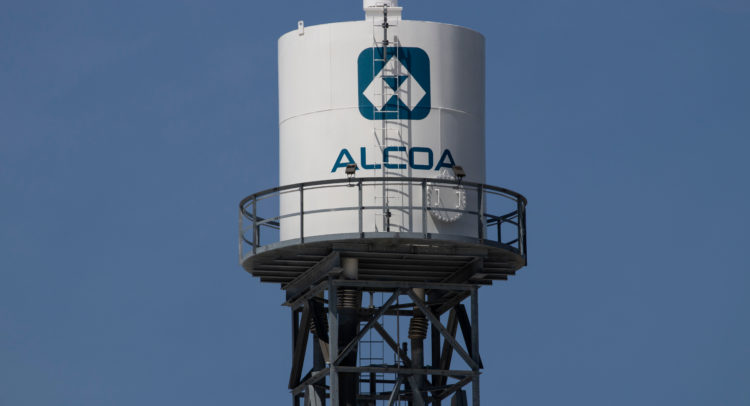Alcoa (AA) has faced severe headwinds from geopolitical issues, which have caused its stock price to plummet from its March 24 peak.
Claim 50% Off TipRanks Premium and Invest with Confidence
- Unlock hedge-fund level data and powerful investing tools designed to help you make smarter, sharper decisions
- Stay ahead of the market with the latest news and analysis so your portfolio is always positioned for maximum potential
Investors are understandably disappointed, but if they think the stock hasn’t got a chance to get back on track at this point, in my opinion, they are making a big mistake in judgment. Thus, I would keep on holding Alcoa.
About Alcoa
Alcoa is a seller in the global bauxite, alumina and aluminum products markets, and holds leading positions in many of these markets. Alcoa also manufactures these products itself.
In terms of Q1 2022 adjusted EBITDA, these three markets contributed to the total as per the following percentages: bauxite segment by 4%, alumina segment by 26% and aluminum segment by 70%.
These markets are in North America, Spain, Australia, Iceland, Norway, Brazil and internationally.
Alcoa’s products are used extensively in the construction, metallurgy, glass and ceramics industries. They are used to make abrasives, bricks, various refractory coatings and to add pigment to paints and varnishes.
Alcoa’s headquarters are in Pittsburgh, Pennsylvania.
Update from Regional Markets
In Brazil, the company will complete the sale of certain assets over the coming months.
Regarding Russia, Alcoa has decided to stop doing business with Russian suppliers and customers. This is in-line with the policies of the G7 governments towards President Vladimir Putin’s regime and its aggression toward Ukraine.
Alcoa has assured its shareholders that this shift will have no financial impact as management has put workarounds in place.
In Spain, Alcoa has reached an agreement with local unions to operate certain aluminum smelters at reduced capacity, which will provide significant protection against high energy costs in Spain.
The Price of Aluminum, Recent Headwinds
The futures contract market provides a good place to get an idea of recent aluminum price developments. Here the industrial good is trading at $2,891 per ton (as of this writing), roughly reflecting a 25% decline from the all-time high set in early March 2022.
The main reasons for the decline lie in the actions of the People’s Republic of China and the monetary policies of some of the world’s major central banks.
The restrictions on economic activity, meant to limit the resurgence of infections from COVID-19 in China, have raised concerns about aluminum demand, as China is the world’s largest consumer.
The monetary policies of the U.S. Federal Reserve and other central banks such as in the UK and Australia are also affecting aluminum demand estimates. This has led analysts to expect downward movement, although this time on a global scale.
The decision by these top monetary authorities to raise interest rates on checking accounts, making debt more expensive, is viewed with concern. This is as economic growth could falter in an attempt to contain inflation, leading to a recession or worse, stagflation.
Market Concerns are Probably Overblown
Regarding lockdowns, the Chinese government has adapted its policies and now can respond to its needs in less impactful, more flexible manner. 85% of the most vulnerable and elderly population in China are now fully vaccinated, while 65% have received a booster shot.
As for the second concern, monetary tightening doesn’t guarantee a full-blown recession. It is possible that if the Fed can manage to bring inflation down, consumer confidence could improve enough to boost demand for durable goods and other products that use aluminum.
Also, while monetary tightening in Europe is likely to come after European Central Bank (ECB) President Christine Lagarde yesterday signaled a possible rate hike for July, it may not be as depressing for private spending as is widely feared. Due to the precariously fragile environment in Europe at the moment, the ECB’s policy cannot deviate significantly from the fiscal policies of the individual European Union governments.
China Surprises: A Big Boost for Aluminum
A powerful catalyst for aluminum globally is the rapid development of road and river infrastructure in the People’s Republic of China.
Capital invested in China’s road and river infrastructure continues to grow dramatically, rising 7% to more than $107 billion in the first four months of 2022, China’s Ministry of Transport recently said.
The huge country is already the world’s largest consumer of aluminum, and this massive allocation to mainland roads and waterways could offset any negative impact on demand ahead of higher global interest rates.
From current levels, aluminum is likely to rise 4.4% to $3,017.59 per ton by June 30 and 12.2% to $3,242.96 per ton over the next 52 weeks, economists estimate.
What Higher Demand and Prices Could Mean for Alcoa
In view of the above, there is a chance that the following company’s guidance on bauxite and aluminum shipments will be exceeded.
The company forecasts bauxite shipments of 46 million to 47 million dry-weight tons in 2022. It forecasts total alumina shipments of between 14.2 million and 14.4 million tons and aluminum shipments of between 2.5 million and 2.6 million tons.
Additional shipments coupled with an expected improved pricing environment for the industrial product could allow Alcoa to post another record EBITDA after the $1 billion reported for the first quarter of 2022.
Assuming operational profitability improves, Alcoa will have more leeway to eventually increase its quarterly dividend, which typically acts as a catalyst for higher stock prices.
Regarding its dividend, the company currently pays a quarterly dividend of $0.10 per common share, with the next payout expected on June 3.
The payment leads to a forward dividend yield of 0.63% at the time of writing.
The Financial Condition
The company is on track to strengthen the balance sheet which had $1.6 billion in cash on hand versus $1.8 billion in total debt as of March 31, 2022.
Further evidence of its solid financial position is shown by it’s debt-to-EBITDA ratio, which measures Alcoa’s ability to pay off its debt with one of its first income lines, is high, as the annualized ratio comes in at 0.46.
Alcoa typically takes less than six months to pay off all outstanding debt with EBITDA.
Simply put, unless there are tangible assets to cover the debt, a debt-to-EBITDA ratio of more than four is usually considered a bad sign.
Wall Street’s Take
In the past three months, 13 Wall Street analysts have issued a 12-month price target for AA. The company has a Moderate Buy consensus rating based on seven Buys, six Holds, and zero Sell ratings.
The average Alcoa price target is $95.23, implying a 47.64% upside potential.

Valuation
Shares are changing hands at $63.14 as of the writing of this article for a market cap of $11.65 billion and a 52-week range of $31 to $98.09.
Following a more than 35% drop from its March 24 highs, the stock price is nearly 21% below the 50-day moving average of $74.9. The share price is cheaper than it was just a few weeks ago, which combined with the impressive upside potential, makes Alcoa a compelling stock.
Conclusion
Despite strong headwinds, the stock still represents a solid company poised to benefit from an expected improvement in aluminum market fundamentals.
There’s more than one chance for Alcoa to get back on track.
Read full Disclosure
















